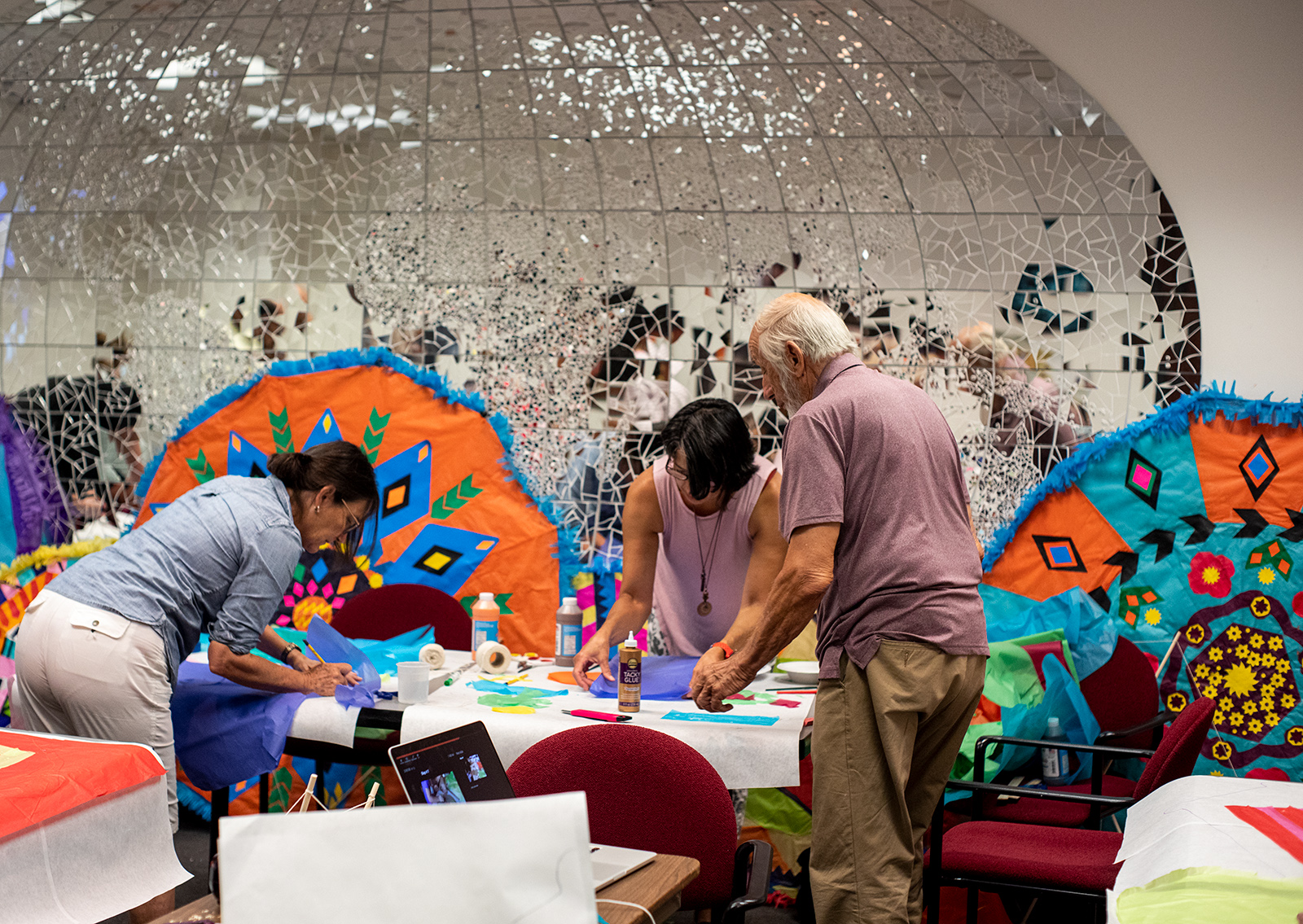Fowler Museum strings together weekend workshops to teach Guatemalan kite-making

The Giant Kites of Guatemala event taught attendees how to make a Guatemalan five-pointed star kite. These smaller style kites eventually led to larger ones, which can weigh hundreds of pounds and are used in Guatemalan Day of the Dead celebrations. While the Day of the Dead is not until November, the workshop taught attendees about the kite’s traditional origins. (Tanmay Shankar/Assistant Photo editor)
By Jordan Wilson
Aug. 4, 2019 11:12 p.m.
Adults and children got hands-on with a high-flying Guatemalan tradition at the Fowler Museum.
On Saturday and Sunday, the museum collaborated with the UCLA Latin American Institute to hold the Giant Kites of Guatemala event, which featured two workshops where participants constructed Guatemalan kites. Veronica Zavala, an outreach coordinator for the Latin American Institute, led the classes where attendees learned how to create a five-pointed star kite – a common shape in most ceremonial Guatemalan kites. Zavala said the original small kites have given rise to the present-day humongous ones, which are typically seen during Day of the Dead celebrations in Sumpango, Guatemala.
“(The kites) can be more than 45 feet in diameter and weigh as much as 200 pounds,” Zavala said. “It takes months to make it … about two to three months before the festival in November.”
Zavala said her goal was for participants in the Fowler workshop to walk away with a kite about 36 inches in diameter, which they could make in a single day. The workshop’s kites feature a five-pointed star design, originally used in a Day of the Dead ceremony, which involved writing messages or drawing images on the face of the kite, she said.
[RELATED: Curator discusses historical insights held within Benin bronzes at Fowler Museum]
During the multiday ceremony in early November, families lay kites on the graves of their deceased loved ones. The kites are meant to invite the spirits of their ancestors back to the earthly plane to be with their family, Zavala said. This tradition tends to be overlooked, Zavala said, but she wanted to impart the spiritual tradition of Guatemalan kite-making in the workshop. The messages written on them serve as offerings in ceremony, she said.
“Instead of having an offering on an altar, the offering is on the kite,” Zavala said.
Fowler Museum curator Greg Sandoval said the museum was excited to offer a class in association with another current exhibit. The idea for the kite-building program sprang from the museum’s current exhibition of historic masks, which were used in Guatemalan religious ceremonies, Sandoval said. Although the tradition of kite-building has long been associated with the Day of the Dead festival in November, Sandoval said he wanted to hold the workshop a little sooner than that.
“(Guatemalan) kites are generally associated with the Day of the Dead, but our exhibit closes a little before that,” Sandoval said. “It was important to us to have a program that brought attention to contemporary artistic practices.”
[RELATED: Mask exhibit to explore intersection of Catholic, Guatemalan tradition]
The opportunity to practice some of her native artwork originally drew Carla Escobar to attend the workshop with her father, Otto Escobar. The pair said they work for the consulate of Guatemala, and are organizers for Festival Chapin – an annual Guatemalan cultural festival. Escobar said she appreciated the attention the Fowler Museum was paying to Guatemalan culture through its workshop.
“It’s exciting to see a school that is so close to home for us to be giving back to the (Guatemalan) community in some way,” Carla Escobar said.
The father and daughter team chose to design their kite with a picture of a well-known volcano in Guatemala – the Volcán de Agua, or “Water Volcano.” Light blue tissue paper surrounded the volcano, mimicking the color of the country’s flag, Otto Escobar said.
“We wanted to show that Guatemala is a country of volcanos,” Otto Escobar said. “We wanted to do something that reminds us of home.”
Although Zavala said the kites were used ceremonially in the 1990s, they later began acting as a platform for politics and social activism. Instead of messages written to deceased ancestors, Zavala said kites began to depart from their traditional role, instead being decorated with political messages or thoughts for the living. Zavala said there were kites made when Guatemalan activist Rigoberta Menchú won the Nobel Peace prize in 1992, exemplifying the use for the kites.
Though traditions may vary, Zavala said there are still many Guatemalans who continue to make kites on a smaller scale like those from the workshops. Zavala said she wanted to emphasize the historical importance of the kites, and how exemplary they are of traditional Guatemalan craftsmanship. Even the bamboo and the type of paper used in the workshop’s designs go all the way back to the period of Aztec civilization, she said.
“The kites involve many different kinds of art, geometry and crafting,” Zavala said. “We are doing (the workshop) not so much in celebration of the Day of the Dead, but as an acknowledgement of our practice.”

